|
|
|
Sort Order |
|
|
|
Items / Page
|
|
|
|
|
|
|
| Srl | Item |
| 1 |
ID:
152350
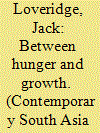

|
|
|
|
|
| Summary/Abstract |
Built from the ground up by three thousand Sikh and Hindu refugees in the aftermath of the Partition of India in 1947, the town of Nilokheri in East Punjab emerged as an unlikely centre of agricultural education and scientific exchange. With support from the Ford Foundation, Indian and American scientists and development planners worked through the 1950s to transform the refugee township into a model of agricultural innovation and community development. Prime Minister Jawaharlal Nehru even cast Nilokheri as the first step on the ‘road to new India’ that would bring the nation to self-sufficiency in food production. Over the course of a decade, experimental farms, workshops, and agricultural training centres rose around the village. The bustling town rapidly became an internationally recognised centre for deploying new farming technologies, training farmers, and sharing scientific knowledge. Yet for all its initial promise, allegations of bureaucratic mismanagement dogged the project, floodwaters disrupted the site in 1957, and Ford’s interest shifted by the early 1960s. The Nilokheri experiment, however, set the stage for the scientific and social interventions of India’s Green Revolution, contributing to an international development paradigm that persists today.
|
|
|
|
|
|
|
|
|
|
|
|
|
|
|
|
| 2 |
ID:
152348
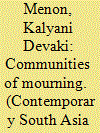

|
|
|
|
|
| Summary/Abstract |
In this article, I examine how Old Delhi’s Shias construct community across religious and sectarian lines to live with others in contemporary India. I focus on the Islamic month of Muharram, when Shias ritually mourn the death of Imam Husain and his companions at the Battle of Karbala. Often a period marked by sectarian violence and tension in South Asia, here I focus on everyday attempts to bridge difference, diffuse tensions, and enable broader understandings of community amongst Old Delhi’s Muslims, and between Muslims and Hindus. Drawing on ethnographic fieldwork conducted amongst diverse groups of Muslims residing in Old Delhi, I examine how religious practices and narratives during and immediately after Muharram, provide an arena for new ways of positioning Shias in Old Delhi, and in India today. I argue that Shii rituals and narratives during Muharram, while marking religious and sectarian distinctions, simultaneously enable forms of identity that challenge exclusionary constructions of community and nation and allow Old Delhi’s diverse communities to live with difference in contemporary India.
|
|
|
|
|
|
|
|
|
|
|
|
|
|
|
|
| 3 |
ID:
152347
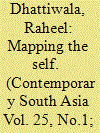

|
|
|
|
|
| Summary/Abstract |
Ethnic riots in India rarely lead to convictions of perpetrators and redress for victims. By implication, antagonisms prevail years after violence has ceased and victims often find themselves sharing everyday spaces with their attackers. The task of identifying the risk factors leading to ethnic violence as well as the nuances of coexistence for individuals ridden with memories of violence and prejudice is rife with methodological and ethical challenges. Concerns surrounding data quality are enhanced when the researcher is also an insider. In a study spanning 26 months (undertaken between 2010 and 2015), I examine the challenges of an insider researcher in the context of Hindu–Muslim violence that occurred in Gujarat in 2002, and offer techniques to improve data quality. Strategies include the cross-verification of sources within official data; interviewing respondents in group and individual settings to address the attitudinal fallacy; and employing respondent-empowered cognitive maps. I argue that visual data, such as cognitive maps, enable a better understanding of abstract social concepts and also facilitate a balance between distance and involvement for the insider researcher.
|
|
|
|
|
|
|
|
|
|
|
|
|
|
|
|
| 4 |
ID:
152351
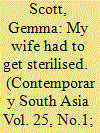

|
|
|
|
|
| Summary/Abstract |
Existing scholarship on the Emergency’s sterilisation programme largely excludes women’s experiences, echoing the Shah Commission of Inquiry’s focus on men’s complaints against the government in its published reports. This paper re-orients historical understandings of this programme to account for female sterilisation during 1975–1977. By reading the Commission’s extensive collection of archived files against the grain, I use the male-dominated archive to illuminate the gendered nature of this policy and its effects on India’s women. Against dominant perceptions that the Emergency’s sterilisation programme focused entirely on vasectomy, this paper discusses instances where women were critical in families’ attempts to negotiate the regime’s coercive measures. It also analyses the negative impacts of coercion on the ‘girl child’ and the consequences of the Emergency’s single minded focus on sterilisation for the Mother and Child Health programme. Through these discussions I argue that such measures exacerbated existing gendered biases. In doing so, this paper challenges dominant understandings of the Emergency’s sterilisation programme and explores women’s experiences.
|
|
|
|
|
|
|
|
|
|
|
|
|
|
|
|
| 5 |
ID:
152349
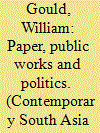

|
|
|
|
|
| Summary/Abstract |
In moving away from older linear narratives around the costs and benefits of ‘corruption’ to development and democratic processes, social scientists have tended to downplay temporality in their work on the phenomenon in the global South. Historical research, however, offers a different kind of nuance around moments in which corruption becomes important in political and administrative discourse. Examining archives on corruption in detail and comparatively poses different questions about the operation of the everyday state. It also provides alternative means for exploring the nature of citizenship, national belonging in India and how the disempowered are often unevenly affected by corrupt acts. Using two case studies in the Public Works Department during state transition in the late 1940s and early 1950s, in India’s most populous state, Uttar Pradesh, this article examines how archives convey multiple and contingent meanings to early postcolonial discourses of ‘corruption’. Such archives present the phenomenon as a vehicle or symbolic resource for larger political processes over the period. This potentially challenges our perspective on some of the larger questions surrounding the early postcolonial state, the nature of civil/political society in that period for India, ideas of national belonging and the relationship between India and Pakistan.
|
|
|
|
|
|
|
|
|
|
|
|
|
|
|
|
| 6 |
ID:
152352
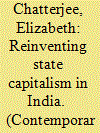

|
|
|
|
|
| Summary/Abstract |
Despite three decades of liberalization, the public sector’s contribution to the Indian economy remains crucial but underappreciated. Particularly striking is the resilience of central public sector enterprises. The best of these have been reinvented: retrofitted for the market era, exposed to competition and endowed with at least the trappings of corporate governance. Elsewhere in the world, such state-market hybrids have been seen as characteristic of a powerful new model: ‘state capitalism 2.0’. How, then, do these reinvented central enterprises fit within India’s contemporary liberalization process? From the vantage point of the energy sector, in which India’s largest state-owned enterprises (SOEs) predominantly lie, this article seeks to shed light on key continuities and changes in India’s underlying regime of state capitalism. It argues that the most successful central SOEs institutionalize a pragmatic variant of liberalization, in which public versus private ownership matters less than ideas of managerial efficiency and market discipline. Yet this does not amount to a coherent alternative to deregulation or first-generation state capitalism. Instead these enterprises are treated with an admixture of neglect and short-term exploitation, milked for resources to fund a wide system of subsidies. India’s second-generation state capitalism is distinguished from its older incarnation less by the declining role of the state than by the increasingly pro-business nature of these transfers.
|
|
|
|
|
|
|
|
|
|
|
|
|
|
|
|
|
|
|
|
|